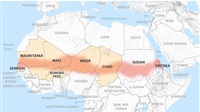Anger mounts over selective US curfew rules: 'A license to decide who to arrest'

Cities across the US have enacted curfews in an
attempt to quell the unrest over the killing of George Floyd in police custody.
But the selective enforcement of the curfew orders only underscores the
demonstrators’ message about law enforcement abuses, civil liberties experts
warn.
The vague, broad language in these orders gives law
enforcement leeway to pick and choose when to arrest someone for violating
curfew, allowing for situations that are ripe for abuse, experts said. In some
cities, this has worked in protesters’ favor when police chose not to arrest
them. But when police enforce an order in some cases and not others, the order
becomes an arbitrary tool of control that often appears to violate protesters’
constitutional rights to assembly and free speech.
“The amount
of discretion and the ways these laws are written are perpetuating the same
injustices that our communities are out there protesting right now,” Shilpi
Agarwal, a senior attorney at the American Civil Liberties Union of northern
California, told the Guardian. “The thing that has inspired these protests and
triggered this pain in folks is this flagrant abuse of power by police. The
response to that should not be to further empower the police.”
In some locations, police have appeared to give
certain people a free pass. In Salem, Oregon, the police chief was forced to
issue a public apology after an officer was filmed Monday telling armed white
men to duck into businesses or vehicles once curfew hits so “we don’t look like
we’re playing favorites”.
Elsewhere, police have treated curfew deadlines as a
“flexible tool”.
In Los Angeles, where a curfew was in effect until
Thursday, the sheriff’s department tweeted that they would not begin enforcing
the curfew until 10pm, though the countywide curfew began an hour earlier.
The Los Angeles sheriff, Alex Villanueva, described
the curfew as an “advantage” for law enforcement because “anyone who is present
we have the probable cause to arrest, and we are making arrests by the
hundreds”. Since Friday, police have arrested more than 3,000 people in Los
Angeles county, the majority of which were for failure to disperse or breaking
curfew.
In Oakland, where a curfew was also in effect until
Thursday, the interim police chief, Susan Manheimer, said officers “chose not
to enact the curfew” at demonstrations that drew hundreds out because they had
remained “peaceful”. She described the curfew as “a flexible tool that will be
applied with discretion”.
“That’s not how the law works nor is that how the
constitution works,” Agarwal said. “Laws have to be clear about what is
prohibited or not. We need to know as citizens what actions we can or cannot
do, what crimes are or are not allowed. We can’t give police the license to
decide who or who not to arrest.”
Local leaders across the country have justified
these curfews by pointing at the looting and vandalism that have accompanied
the protests and marches, calling the curfews a matter of public safety. But
prior to the lifting of the curfew in Los Angeles county – and a lawsuit filed
by the ACLU and Black Lives Matter Los Angeles – the sheriff had said that the
curfew “will continue on a daily basis until the organized protests are gone”.
“It’s quite clear that the curfews are being enacted
in order to quell protest,” the civil rights attorney Rachel Lederman told the
Guardian.
Lederman was the attorney who led a lawsuit against
San Francisco during one of the only other times in recent history that the
city enacted a curfew – after the verdict in the Rodney King case was announced
in 1992. In 1996, the ninth circuit ruled that “the law is clear that first
amendment activity may not be banned simply because prior similar activity led
to or involved instances of violence”.
“Banning or postponing legitimate expressive
activity because other first amendment activity regarding the same subject has
resulted in violence deprives citizens of their right to demonstrate in a
timely and effective fashion,” the ruling reads.
San Francisco lifted its curfew on Thursday, though
not before arresting a number of protesters, many of whom set out to purposely
defy it. Lederman pointed out that before the 1992 curfew, the last one in San
Francisco was in 1968, after Martin Luther King Jr was assassinated. But the
city didn’t impose a curfew following the mass outrage over the verdict in the
killings of LGBTQ+ leader Harvey Milk and the mayor George Moscone, two white
men, or when sports fans destroyed much of the city and set a municipal bus on
fire while celebrating the San Francisco Giants’ 2012 world series win. “It’s
targeted at black-led, anti-racist protests,” Lederman said.
What was particularly concerning, said Agarwal, was
that many jurisdictions such as Palo Alto and San Mateo county had enacted a
curfew but hadn’t experienced any sort of vandalism or looting. “Cities across
California were just leaping to enforce these very drastic measures based on
what they were afraid might happen,” she said.
Agarwal said she was worried about the future
implications of these curfews.
“A curfew is a very drastic measure that should be
reserved for very extreme circumstances,” she said. “Every citizen should be
afraid of the precedent that this is setting.”







